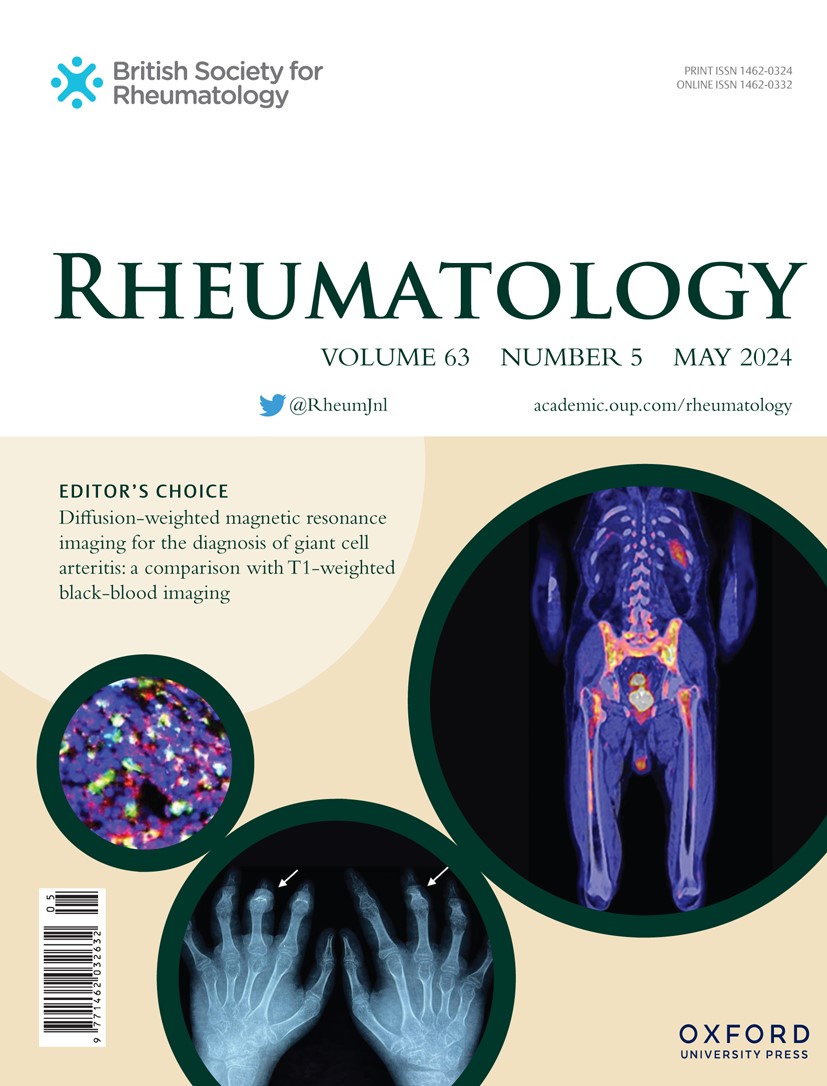肌炎特异性自身抗体亚型与青少年皮肌炎患者对Janus激酶抑制剂的反应相关
IF 4.7
2区 医学
Q1 RHEUMATOLOGY
引用次数: 0
摘要
目的评价Janus激酶抑制剂(JAKi)在单中心系列青少年皮肌炎(JDM)患者中的疗效和安全性,并确定与临床非活动性疾病(CID)实现相关的因素。方法对39例JDM患者进行6个月以上JAKi治疗的单中心回顾性研究。使用PRINTO标准和皮肤病活动评分评估JAKi开始后6个月内达到CID的患者比例。1型干扰素(IFN)基因标记、血清IFN-α和IFN-β蛋白滴度作为潜在反应的生物标志物。结果39例JDM患者入选。治疗6个月后,32/39(82%)患者实现部分或完全CID。在应答者中,平均类固醇剂量从1 mg/kg/d降至0 mg/kg/d (p= 0.001),所有其他药物均被停药。在多变量分析中,抗tif -1γ抗体的存在是JDM发病与CID缺失相关的唯一因素(p<;0001年。从JDM诊断到6个月的随访,仅在CID患者中观察到1型IFN评分和血清IFN- α的中位数显著下降。与jaki相关的不良事件包括9例感染(包括5例带状疱疹感染)和3例体重增加。JAKi在大多数新发难治性JDM患者中诱导CID,除了一小部分难治性TIF-1γ阳性JDM患者。总体容忍度是可以接受的。这些结果需要在更大的前瞻性国际队列研究中得到验证。本文章由计算机程序翻译,如有差异,请以英文原文为准。
Myositis specific autoantibody subtypes are associated with response to Janus kinase inhibitors in patients with juvenile dermatomyositis
Objectives To evaluate the efficacy and safety of Janus kinase inhibitors (JAKi) in a monocentric series of patients with juvenile dermatomyositis (JDM) and to identify factors associated with the achievement of clinically inactive disease (CID). Methods Single-centre retrospective study of 39 JDM patients treated with JAKi fot at least 6 months. The proportion of patients achieving CID within 6 months after initiation of JAKi was assessed using the PRINTO criteria and the Skin Disease Activity Score. Type 1 interferon (IFN) gene signature, serum IFN-α and IFN-β protein titres were measured as potential response biomarkers. Results 39 patients with JDM were included. Partial or complete CID was achieved in 32/39 (82%) patients after 6 months of treatment. In responders, the mean steroid dose decreased from 1 to 0 mg/kg/d (p= 0.001) and all other medications were withdrawn. In multivariable analysis, the presence of anti-TIF-1γ antibodies was the only factor at JDM onset associated with the absence of CID (p< 0,001. A significant decrease in the median Type 1 IFN score and serum IFN- α from the diagnosis of JDM to the 6-months follow-up was observed only in patientswith CID. JAKi-related adverse events consisted of infections in 9 patients (including 5 herpes zoster infections) and weight gain in 3 patients. Conclusions JAKi induced CID in the majority of new-onset and refractory JDM patients, except in a subset of patients with refractory TIF-1γ positive JDM. Overall tolerance was acceptable. These results need to be validated in a larger prospective international cohort study.
求助全文
通过发布文献求助,成功后即可免费获取论文全文。
去求助
来源期刊

Rheumatology
医学-风湿病学
CiteScore
9.40
自引率
7.30%
发文量
1091
审稿时长
2 months
期刊介绍:
Rheumatology strives to support research and discovery by publishing the highest quality original scientific papers with a focus on basic, clinical and translational research. The journal’s subject areas cover a wide range of paediatric and adult rheumatological conditions from an international perspective. It is an official journal of the British Society for Rheumatology, published by Oxford University Press.
Rheumatology publishes original articles, reviews, editorials, guidelines, concise reports, meta-analyses, original case reports, clinical vignettes, letters and matters arising from published material. The journal takes pride in serving the global rheumatology community, with a focus on high societal impact in the form of podcasts, videos and extended social media presence, and utilizing metrics such as Altmetric. Keep up to date by following the journal on Twitter @RheumJnl.
 求助内容:
求助内容: 应助结果提醒方式:
应助结果提醒方式:


